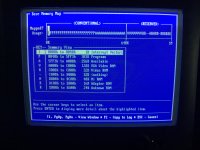SteveG
Experienced Member
I am trying to load Windows 3.1 onto my IBM PC/AT.
I get error when I load the Windows 3.1 Setup Disk.
ERROR: no available extended memory was found .
XMS driver not installed.
I assume Windows 3.1 needs more than 640K of memory to load. Is that correct?
When I run check-it on the AT I get a memory map that indicates that some reserved memory is available (see photo).
Is it possible to re-allocate this reserved memory so that Windows 3.1 can load?

I get error when I load the Windows 3.1 Setup Disk.
ERROR: no available extended memory was found .
XMS driver not installed.
I assume Windows 3.1 needs more than 640K of memory to load. Is that correct?
When I run check-it on the AT I get a memory map that indicates that some reserved memory is available (see photo).
Is it possible to re-allocate this reserved memory so that Windows 3.1 can load?

Last edited:

